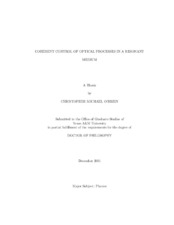| dc.description.abstract | The resonant absorption, emission, and scattering of light are the fundamental optical processes that have been used both to probe matter and to manipulate light itself. In the last decade there has been essential progress in coherent control of both linear and nonlinear optical responses based on resonant excitation of atomic coherence in multilevel quantum systems. Some interesting and useful phenomena, resulting from coherent control of absorption and the group index, such as electromagnetically induced transparency, lasing without inversion, and ultra-slow group velocity of light have been widely studied. This work is focused on coherent control of refractive index and resonant fluorescence in multilevel medium.
We suggest two promising schemes for resonant enhancement of the refractive index with eliminated absorption and propose their implementation in transition element doped crystals with excited state absorption and in a cell of Rb atoms at natural abundance. We show how to use one of these schemes for spatial variation of the refractive index via its periodic resonant increase/decrease, remarkably keeping at the same time zero absorption/gain. It opens the way to production of transparent photonic structures (such as distributed Bragg reflectors, holey fibers, or photonic crystals) in a homogeneous resonant atomic media such as dielectrics with homogeneously distributed impurities, atomic, or molecular gases. These optically produced photonic structures could easily be controlled (including switching on/off, changing amplitude and period of modulation) and would be highly selective in frequency, naturally limited by the width of the optical resonance.
We also derive the optical fluorescence spectra of a three-level medium driven by two coherent fields at the adjacent transitions in a general case when all three transitions are allowed. We show that coherent driving can efficiently control the distribution of intensities between the fluorescent channels. In particular, the total intensity of fluorescence at the transition which is not driven by the optical fields may essentially exceed the fluorescence intensity at the driven transitions under the condition of two-photon resonance. This counter-intuitive effect is due to depletion of the intermediate state via atomic interference. | en |


